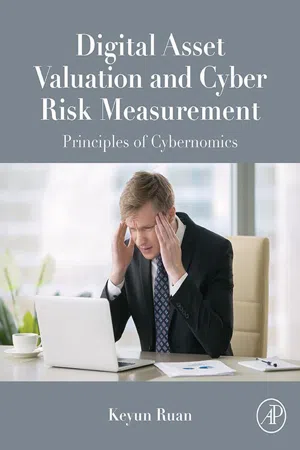
Digital Asset Valuation and Cyber Risk Measurement
Principles of Cybernomics
Keyun Ruan
- 200 Seiten
- English
- ePUB (handyfreundlich)
- Über iOS und Android verfügbar
Digital Asset Valuation and Cyber Risk Measurement
Principles of Cybernomics
Keyun Ruan
Über dieses Buch
Digital Asset Valuation and Cyber Risk Measurement: Principles of Cybernomics is a book about the future of risk and the future of value. It examines the indispensable role of economic modeling in the future of digitization, thus providing industry professionals with the tools they need to optimize the management of financial risks associated with this megatrend. The book addresses three problem areas: the valuation of digital assets, measurement of risk exposures of digital valuables, and economic modeling for the management of such risks. Employing a pair of novel cyber risk measurement units, bitmort and hekla, the book covers areas of value, risk, control, and return, each of which are viewed from the perspective of entity (e.g., individual, organization, business), portfolio (e.g., industry sector, nation-state), and global ramifications. Establishing adequate, holistic, and statistically robust data points on the entity, portfolio, and global levels for the development of a cybernomics databank is essential for the resilience of our shared digital future. This book also argues existing economic value theories no longer apply to the digital era due to the unique characteristics of digital assets. It introduces six laws of digital theory of value, with the aim to adapt economic value theories to the digital and machine era.
- Comprehensive literature review on existing digital asset valuation models, cyber risk management methods, security control frameworks, and economics of information security
- Discusses the implication of classical economic theories under the context of digitization, as well as the impact of rapid digitization on the future of value
- Analyzes the fundamental attributes and measurable characteristics of digital assets as economic goods
- Discusses the scope and measurement of digital economy
- Highlights cutting-edge risk measurement practices regarding cybersecurity risk management
- Introduces novel concepts, models, and theories, including opportunity value, Digital Valuation Model, six laws of digital theory of value, Cyber Risk Quadrant, and most importantly, cyber risk measures hekla and bitmort
- Introduces cybernomics, that is, the integration of cyber risk management and economics to study the requirements of a databank in order to improve risk analytics solutions for (1) the valuation of digital assets, (2) the measurement of risk exposure of digital assets, and (3) the capital optimization for managing residual cyber risK
- Provides a case study on cyber insurance
Häufig gestellte Fragen
Information
Digital Assets as Economic Goods
Abstract
Keywords
1.1 Origins and Philosophical Concepts of Value
1.1.1 Subjective View Versus Objective View
Inhaltsverzeichnis
- Cover image
- Title page
- Table of Contents
- Copyright
- Dedication
- Preface
- Introduction
- Chapter 1. Digital Assets as Economic Goods
- Chapter 2. Digital Theory of Value
- Chapter 3. Cyber Risk Management: A New Era of Enterprise Risk Management
- Chapter 4. Cyber Risk Measurement in the Hyperconnected World
- Chapter 5. Economic Modeling and the Implementation of Effective Mitigating Controls
- Chapter 6. The Point of Diminishing Return on Cyber Risk Investment
- Chapter 7. Kilogram of Cyber Risk: Introducing Bitmort and Hekla
- Chapter 8. Three Views of Cybernomics: Entity View, Portfolio View, and Global View
- Chapter 9. Principles of Cybernomics
- Chapter 10. Case Study: Insuring the Future of Everything
- References
- Index